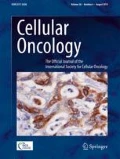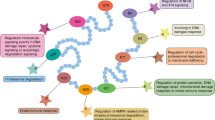Abstract
Purpose
The de-ubiquitinase HAUSP has been reported to exhibit various biological roles implicated in the development of cancer and other pathologies. The dual nature of HAUSP (i.e., oncogenic and tumor suppressive) makes the protein even more versatile. The major aims of this study were to reveal the effect of HAUSP over-expression on the overall proteome and to identify bona fide substrates of HAUSP. In addition, we aimed to unravel the functionality and physiological relevance of the de-ubiquitinating activity of HAUSP on one of its newly identified substrates, TRRAP.
Methods
An overall proteome analysis was performed after exogenous HAUSP over-expression in HEK293 cells, followed by 2-dimensional gel electrophoresis (2-DE). Interacting proteins were subsequently isolated using immunoprecipitation and 1-dimensional gel electrophoresis (1-DE). Both were followed by tandem MALDI-TOF/TOF mass spectrometry and gene ontology-based analyses. To validate the functionality of one of the identified substrates (TRRAP), Western blotting, immunocytochemistry, immunoprecipitation, in vivo de-ubiquitination, quantitative real-time PCR and luciferase assays were performed.
Results
The substrate screening indicated that HAUSP may be involved in tumorigenesis, cytoskeletal organization and transport, and chaperone systems. One candidate substrate, TRRAP, was found to physically interact and co-localize with HAUSP. As TRRAP regulates c-MYC expression, and in order to validate the effect of HAUSP on TRRAP, c-MYC protein and mRNA expression levels were analyzed after exogenous HAUSP over-expression. Both were found to be up-regulated. We also found that c-MYC transactivation increased upon exogenous HAUSP over-expression. By using a luciferase reporter assay, we found that a c-MYC responsive promoter exhibited increased activity, which was subsequently abrogated upon TRRAP knockdown.
Conclusions
From our results we conclude that HAUSP may act as an oncogenic protein that can modulate c-MYC expression via TRRAP. Our results provide a new context in which HAUSP may play a role in cancer cell signalling.




Similar content being viewed by others
References
C.M. Pickart, Mechanisms underlying ubiquitination. Annu. Rev. Biochem. 70, 503–533 (2001)
I. Paul, M.K. Ghosh, A CHIPotle in physiology and disease. Int. J. Biochem. Cell Biol. 58, 37–52 (2015)
J. Yang, Emerging roles of deubiquitinating enzymes in human cancer. Acta Pharmacol. Sin. 28, 1325–1330 (2007)
K.H. Ventii, K.D. Wilkinson, Protein partners of deubiquitinating enzymes. Biochem. J. 414, 161–175 (2008)
S. Hussain, Y. Zhang, P.J. Galardy, DUBs and cancer: the role of deubiquitinating enzymes as oncogenes, non-oncogenes and tumor suppressors. Cell Cycle. Georget. Tex. 8, 1688–1697 (2009)
G. Nalepa, M. Rolfe, J.W. Harper, Drug discovery in the ubiquitin-proteasome system. Nat. Rev. Drug Discov. 5, 596–613 (2006)
A. Rawat, G. Gopal, G. Selvaluxmy, T. Rajkumar, Inhibition of ubiquitin conjugating enzyme UBE2C reduces prolilferation and sensitizes breast cancer cells to radiation, doxorubicin, tamoxifen and letrozole. Cell. Oncol. 36, 459–467 (2013)
R.D. Everett, M. Meredith, A. Orr, A. Cross, M. Kathoria, J. Parkinson, A novel uiquitin-specific protease is dynamically associated with the PML nuclear domain and binds to a herpesvirus regulatory protein. EMBO J. 16, 566–577 (1997)
M. Li, D. Chen, A. Shiloh, J. Luo, A.Y. Nikolaev, J. Qin, W. Gu, Deubiquitination of p53 by HAUSP is an important pathway for p53 stabilization. Nature 416, 648–653 (2002)
J.M. Cummins, B. Vogelstein, HAUSP is required for p53 destabilization. Cell Cycle. Georget. Tex. 3, 689–692 (2004)
B.M. Kessler, E. Fortunati, M. Melis, C.E.G.M. Pals, H. Clevers, M.M. Maurice, Proteome changes induced by Knock-down of the deubiquitylating enzyme HAUSP/USP7. J. Proteome Res. 6, 4163–4172 (2007)
B. Nicholson, K.G. Suresh Kumar, The multifaceted roles of USP7: New therapeutic opportunities. Cell Biochem. Biophys. 60, 61–68 (2011)
S. Daubeuf, D. Singh, Y. Tan, H. Liu, H.J. Federoff, W.J. Bowers, K. Tolba, HSV ICP0 recruits USP7 to modulate TLR-mediated innate response. Blood 113, 3264–3275 (2009)
M. Kalamvoki, H. Gu, B. Roizman, Overexpression of the ubiquitin-specific protease 7 resulting from transfection or mutations in the ICP0 binding site accelerates rather than depresses herpes simplex virus 1 gene expression. J. Virol. 86, 12871–12878 (2012)
M.N. Holowaty, L. Frappier, HAUSP/USP7 as an Epstein-Barr virus target. Biochem. Soc. Trans. 32, 731–732 (2004)
F. Sarkari, X. Wang, T. Nguyen, L. Frappier, The herpesvirus associated ubiquitin specific protease, USP7, is a negative regulator of PML proteins and PML nuclear bodies. PLoS One 6, e16598 (2011)
M.T. Epping, L.A.T. Meijer, O. Krijgsman, J.L. Bos, P.P. Pandolfi, R. Bernards, TSPYL5 suppresses p53 levels and function by physical interaction with USP7. Nat. Cell Biol. 13, 102–108 (2010)
K. Becker, N.D. Marchenko, G. Palacios, U.M. Moll, A role of HAUSP in tumor suppression in a human colon carcinoma xenograft model. Cell Cycle 7, 1205–1213 (2008)
A. van der Horst, A.M.M. de Vries-Smits, A.B... Brenkman, M.H. van Triest, N. van den Broek, F. Colland, M.M. Maurice, B.M.T. Burgering, FOXO4 transcriptional activity is regulated by monoubiquitination and USP7/HAUSP. Nat. Cell Biol. 8, 1064–1073 (2006)
M.S. Song, L. Salmena, A. Carracedo, A. Egia, F. Lo-Coco, J. Teruya-Feldstein, P.P. Pandolfi, The deubiquitylation and localization of PTEN are regulated by a HAUSP-PML network. Nature 455, 813–817 (2008)
S.V. Khoronenkova, I.I. Dianova, J.L. Parsons, G.L. Dianov, USP7/HAUSP stimulates repair of oxidative DNA lesions. Nucl. Acids Res. 39, 2604–2609 (2010)
S. Bhattacharya, M.K. Ghosh, HAUSP, a novel deubiquitinase for Rb-MDM2 the critical regulator. FEBS J. 281, 3061–3078 (2014)
R.E. Kingston, C.A. Chen, H. Okayama, J.K. Rose, Transfection of DNA into eukaryotic cells. Curr. Protoc. Mol. Biol. N. Y. Greene Publ. Wiley Intersci. 9, 1–9 (1987)
S.F. Ahmed, S. Deb, I. Paul, A. Chatterjee, T. Mandal, U. Chatterjee, M.K. Ghosh, The chaperone-assisted E3 ligase C terminus of Hsc 70-interacting protein (CHIP) targets PTEN for Proteasomal degradation. J. Biol. Chem. 287, 15996–16006 (2012)
A.-L. Mahul-Mellier, E. Pazarentzos, C. Datler, R. Iwasawa, G. AbuAli, B. Lin, S. Grimm, Deubiquiintating protease USP2a targets RIP1 and TRAf2 to mediate cell death by TNF. Cell Death Differ. 19, 891–899 (2012)
S.F. Ahmed, N. Das, M. Sarkar, U. Chatterjee, S. Chatterjee, M.K. Ghosh, Exosome-mediated delivery of the intrinsic C-terminus domain of PTEN protects it from proteasomal degradation and ablates tumorigenesis. Mol. Ther. 23, 255–269 (2015)
I. Paul, S.F. Ahmed, A. Bhowmik, S. Deb, M.K. Ghosh, The ubiquitin ligase CHIP regulates c-Myc stability and transcriptional activity. Oncogene 32, 1284–1295 (2013)
S.B. McMahon, H.A. Van Buskirk, K.A. Dugan, T.D. Copeland, M.D. Cole, The novel ATM-related protein TRRAP is essential cofactor for the c-Myc and E2F oncoproteins. Cell 94, 363–374 (1998)
X. Liu, J. Tesfai, Y.A. Evrard, S.Y.R. Dent, E. Martinez, c-Myc transformation domain recruits the human STAGA complex and requires TRRAP and GCN5 acetylase activity for transcriotion activation. J. Biol. Chem. 278, 20405–20412 (2003)
N.S. Kenneth, B.A. Ramsbottom, N. Gomez-Roman, L. Marshall, P.A. Cole, R.J. White, TRRAP and GCN5 are used by c-Myc to activate RNA polymerase III trabscriotion. Proc. Natl. Acad. Sci. 104, 14917–14922 (2007)
J.A. Royds, W.R. Timperley, C.B. Taylor, Levels of enolase and other enzymes in the cerebrospinal fluid as indices of pathological change. J. Neurol. Neurosurg. Psychiatry 44, 1129–1135 (1981)
R.O. Roine, H. Somer, M. Kaste, L. Viinikka, S.L. Karonen, Neurological outcome after out-of-hospital cardiac arrest. Prediction by cerebrospinal fluid enzyme analysis. Arch. Neurol. 46, 753–756 (1989)
A. Fujii, M. Yoneda, T. Ito, O. Yamamura, S. Satomi, H. Higa, A. Kimura, M. Suzuki, M. Yamashita, T. Yuasa, H. Suzuki, M. Kuriyama, Autoantibodies against the amino terminal of alpha-enolase are a useful diagnostic marker of Hashimoto’s encephalopathy. J. Neuroimmunol. 162, 130–136 (2005)
T. Sato, H. Saito, J. Swensen, A. Olifant, C. Wood, D. Danner, T. Sakamoto, K. Takita, F. Kasumi, Y. Miki, The human prohibitin gene located on chromosome 17q21 is mutataed in sporadic breast cancer. Cancer Res. 52, 1643–1646 (1992)
G. Fusaro, P. Dasgupta, S. Rastogi, B. Joshi, S. Chellappan, Prohibitin induces the transcriotional activity of p53 and is exported from the nucleus upon apoptotic signaling. J. Biol. Chem. 278, 47853–47861 (2003)
S. Wang, G. Fusaro, J. Padmanabhan, S.P. Chellappan, Prohibitin-co-localizes with Rb in the nucleus and recruits N-CoR and HDAC1 for transcriptional repression. Oncogene 21, 8388–8396 (2002)
S. Wang, B. Zhang, D.V. Faller, Prohibitin requires Brg-1 and Brm for the repression of E2F and cell growth. EMBO J. 21, 3019–3028 (2002)
N.N. Chuang, C.C. Huang, Interaction of integrin beta 1 with cytokeratin 1 in neuroblastoma NMB7 cells. Biochem. Soc. Trans. 35, 1292–1294 (2006)
F. Mahdi, Z. Shariat-Madar, R.F. Todd, C.D. Figueroa, A.H. Schmaier, Expression and colocalization of cytokeratin 1 and urokinase plasminogen activator receptor on endothelial cells. Blood 97, 2342–2350 (2001)
C.D. Collard, M.C. Montalto, W.R. Reenstra, J.A. Buras, G.L. Stahl, Endothelial oxidative stress activates the lectin complement pathway: role of cytokeratin 1. Am. J. Pathol. 159, 1045–1054 (2001)
M. Sugimoto, A. Inoko, T. Shiromizu, M. Nakayama, P. Zou, S. Yonemura, Y. Hayashi, I. Izawa, M. Sasoh, Y. Uji, K. Kaibuchi, T. Kiyono, M. Inagaki, The keratin-binding protein albatross regulates polarization of epithelial cells. J. Cell Biol. 183, 19–28 (2007)
R. Murr, T. Vaissière, C. Sawan, V. Shukla, Z. Herceg, Orchestration of chromatin-based process: mind the TRRAP. Oncogene 26, 5358–5372 (2007)
Acknowledgments
We thank Mr. Sandip Chakraborty (CSIR-IICB) for operating the MALDI-TOF/TOF instrument and for performing the GPS analyses. This work was funded by the Council for Scientific and Industrial Research grants: EMPOWER-OLP002, MEDCHEM-BSC0108 and miND-BSC0115.
Conflict of Interest
The authors declare no conflict of interest.
Author information
Authors and Affiliations
Corresponding author
Rights and permissions
About this article
Cite this article
Bhattacharya, S., Ghosh, M.K. HAUSP regulates c-MYC expression via de-ubiquitination of TRRAP. Cell Oncol. 38, 265–277 (2015). https://doi.org/10.1007/s13402-015-0228-6
Accepted:
Published:
Issue Date:
DOI: https://doi.org/10.1007/s13402-015-0228-6




